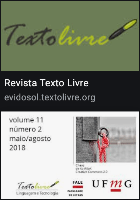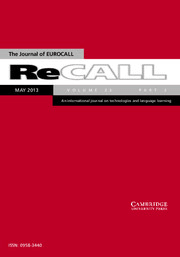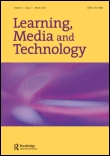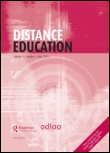
Journal of Interactive Media in Education
Scope & Guideline
Fostering Inclusivity in Educational Media Innovation
Introduction
Aims and Scopes
- Innovative Learning Approaches:
The journal emphasizes research on innovative pedagogical approaches, particularly those integrating technology and interactive media to improve student engagement and learning outcomes. - Accessibility and Inclusivity in Education:
A core area of focus is understanding and improving accessibility in educational technologies, ensuring that diverse learner needs are met, and promoting equitable access to learning resources. - Professional Development for Educators:
The journal highlights the importance of ongoing professional development for educators in the context of digital transformation, exploring how educators can adapt to and utilize new technologies effectively. - Impact of Social Media and Digital Communities:
Research on the role of social media and digital communities in education is a consistent theme, examining how these platforms can enhance collaboration, engagement, and identity formation among learners and educators. - Open Education and Learning at Scale:
The journal also focuses on open educational practices and the scalability of learning through MOOCs and other online platforms, analyzing their impact on educational systems and individual learning experiences.
Trending and Emerging
- MOOCs and Learning at Scale:
Research on MOOCs continues to grow, with a focus on understanding their impact on learner engagement, accessibility, and the overall landscape of higher education, as well as their legacy and future potential. - Digital Wellbeing and Mental Health:
There is an increasing emphasis on the intersection of technology and mental health, exploring how digital tools can support positive learner identities and enhance student wellbeing in technology-enhanced learning environments. - Critical Media Literacy:
Emerging research on critical media literacy highlights the importance of equipping learners with skills to navigate and analyze information in digital contexts, particularly in response to the rise of misinformation. - Hybrid and Flexible Learning Models:
The trend towards hybrid and flexible learning models is gaining traction, with research focusing on student agency, self-regulated learning, and the effectiveness of blended learning environments. - Equity and Access in Education:
There is a strong focus on equity and access issues, particularly in low-resource contexts, emphasizing the need to address barriers to learning and promote inclusive practices in digital education.
Declining or Waning
- Traditional Classroom Practices:
Research focusing on traditional, non-digital classroom practices is becoming less frequent as the emphasis shifts towards innovative and technology-enhanced learning environments. - Static Educational Resources:
There is a notable decline in studies centered on static educational resources, such as traditional textbooks, as more research highlights the need for interactive, adaptive, and engaging learning materials. - Generalized Educational Research:
The scope of generalized educational research that lacks a specific focus on technology integration or interactive media is diminishing, with a growing preference for research that addresses specific technological applications in education. - Conventional Assessment Methods:
Research on conventional assessment methods is waning as the journal increasingly prioritizes studies that explore alternative and innovative assessment strategies in digital and hybrid learning environments. - Limited Scope of Microcredentials:
While microcredentials were once a hot topic, the focus on their limited application and impact is decreasing, as more emphasis is placed on broader frameworks for professional development and lifelong learning.
Similar Journals

Eduweb-Revista de Tecnologia de Informacion y Comunicacion en Educacion
Connecting Knowledge and Technology for Educational ExcellenceEduweb-Revista de Tecnologia de Información y Comunicación en Educación is a pioneering journal published by UNIV CARABOBO, dedicated to the intersection of technology and education. With an ISSN of 1856-7576, this peer-reviewed journal serves as a vital platform for researchers, educators, and technologists to share compelling findings, innovative methodologies, and scholarly discourse on the integration of ICT (Information and Communication Technology) in educational settings. Although specific impact factors and HIndex data are currently unavailable, the journal aims to foster a deeper understanding of how technology can enhance learning outcomes. By being open access, the journal ensures that valuable knowledge is disseminated to a global audience, thereby promoting inclusive education practices. Situated in Venezuela, Eduweb embodies a commitment to advancing educational paradigms through the thoughtful application of technology, making it an essential resource for anyone invested in the future of education.

ReiDoCrea-Revista Eectronica de Investigacion y Docencia Creativa
Exploring New Frontiers in Educational ResearchReiDoCrea-Revista Electrónica de Investigación y Docencia Creativa is a distinguished academic journal published by UNIV GRANADA, FAC CIENCIAS EDUCACION, aimed at advancing research and innovative teaching practices in the field of education. With its inception in 2012, this Open Access journal ensures that research findings and educational strategies are accessible to a global audience, fostering collaboration and development among educators, researchers, and students. While its H-index is currently not specified, ReiDoCrea is committed to publishing high-quality, peer-reviewed articles that stimulate scholarly dialogue and reflection on pedagogical innovation. Its relevance in the educational landscape is underscored by its focus on creative approaches to teaching and learning, making it an essential resource for those seeking to enhance educational practices. With a commitment to impactful research dissemination, ReiDoCrea provides a vital platform for sharing insights and innovations that contribute to the evolution of educational methodologies.

Texto Livre-Linguagem e Tecnologia
Innovating Research at the Confluence of Language and Technology.Texto Livre-Linguagem e Tecnologia is a prominent academic journal published by the Federal University of Minas Gerais, Faculty of Letters, specializing in the interdisciplinary domains of language, technology, and communication. Since its establishment, the journal has embraced an Open Access model, fostering unrestricted dissemination of research findings. With an ISSN of 1983-3652, it aims to bridge theoretical insights and practical applications in linguistics and technology, thereby enriching scholarly dialogues worldwide. The journal's recent classifications in the 2023 Category Quartiles highlight its relevance, achieving Q3 in Communication, Q4 in Computer Science Applications, and Q2 in Linguistics and Language. Additionally, it has earned respectable Scopus rankings, placing it within the 71st percentile for Language and Linguistics in the Arts and Humanities. This positions Texto Livre as a vital resource for researchers, professionals, and students keen on exploring the dynamic interplay between language and technology. By engaging with cutting-edge research, contributors and readers alike can shape the future discourse in these critical fields.

ReCALL
Transforming Language Education with Cutting-Edge ResearchReCALL is a prestigious academic journal published by Cambridge University Press, focusing on the rapidly evolving interplay between technology and language learning. Established in 1989, this quarterly journal holds a distinguished Q1 ranking across multiple categories including Computer Science Applications, Education, and Linguistics and Language, reflecting its commitment to the highest standards of scholarly excellence. With an impressive Scopus ranking that places it in the top percentiles across its fields, ReCALL serves as a vital resource for researchers, educators, and professionals interested in the integration of technology in language education. It features cutting-edge research articles, innovative methodological approaches, and comprehensive reviews that offer insights into the current trends and future directions of language learning, teaching, and assessment. By providing a platform for penetrating inquiry and dialogue, ReCALL significantly enhances the discourse surrounding computer-assisted language learning (CALL) and its influence on educational practices worldwide.

Chemistry Teacher International
Fostering Collaboration in Chemistry EducationChemistry Teacher International is a prominent peer-reviewed journal dedicated to the field of chemistry education, published by WALTER DE GRUYTER GMBH. With its Open Access policy since 2018, this journal ensures that research is widely disseminated to educators, researchers, and practitioners globally. Located in Berlin, Germany, it aims to promote innovative teaching methodologies and practical applications in chemical sciences. The journal has consistently achieved a Q2 ranking in both the Chemistry (Miscellaneous) and Education categories as of 2023, reflecting its relevance and impact within the academic community. Over its converged years from 2019 to 2024, Chemistry Teacher International fosters a collaborative platform for sharing research, insights, and pedagogical strategies, thereby contributing to the advancement of chemistry education on a global scale.

Computers and Education Open
Fostering collaboration in educational innovation.Computers and Education Open is a pioneering open access journal published by Elsevier that focuses on advancing the field of educational technology and digital learning methodologies. Since its inception in 2020, the journal has provided a platform for researchers, educators, and practitioners to disseminate innovative findings and share insights related to the integration of computing technologies in educational settings. With its ISSN 2666-5573, this journal aims to bridge the gap between technology and education, fostering a collaborative environment for those dedicated to enhancing learning experiences through computational tools. Leveraging the rigorous standards of Elsevier's publishing excellence, Computers and Education Open attracts high-quality research that influences pedagogical practices and educational policies globally. The open access nature of the journal ensures that valuable knowledge is freely accessible, making it an essential resource for academics and professionals looking to stay at the forefront of educational advancements.

Learning Media and Technology
Pioneering research for a tech-driven learning environment.Learning Media and Technology, published by Routledge Journals, Taylor & Francis Ltd, is a leading academic journal that stands at the intersection of education and media technology. With its ISSN 1743-9884 and E-ISSN 1743-9892, this esteemed publication has achieved a remarkable Q1 ranking in both the Education and Media Technology categories as of 2023, positioning it within the top-tier journals in these fields. The journal's impressive Scopus rankings further underscore its significance, with a notable rank of #34 out of 1543 in Education and #4 out of 63 in Media Technology, reflecting its high impact and contribution to ongoing research. Covering a wide range of topics from innovative teaching practices to the evolving role of technology in education, the journal aims to foster critical discourse and disseminate pioneering research findings to a global audience. Although it does not currently offer open access, its comprehensive coverage and authoritative insights make it an essential resource for researchers, professionals, and students looking to enrich their understanding of how learning media and technology shape educational landscapes from 2005 to 2024.

Educacion XX1
Innovating Pedagogy: Insights for Tomorrow's ClassroomEducacion XX1 is a premier academic journal dedicated to the field of education, published by UNIV NACIONAL EDUCACION DISTANCIA in Spain. With an impressive impact factor and recognition in the Q1 category for 2023 in education, this open-access journal has served as a significant platform for innovative research since 2000. The journal aims to share high-quality empirical studies, theoretical discussions, and reviews that address contemporary educational challenges, promoting a deeper understanding of pedagogical practices and policies. As evidenced by its Scopus ranking of #122/1543 in Social Sciences - Education, along with a notable percentile of 92, Educacion XX1 continues to contribute to the scholarly community while fostering global discourse and collaboration. With a diverse range of articles covering various topics and perspectives, this journal is invaluable for researchers, professionals, and students alike, providing insights essential to advancing education in today’s rapidly evolving landscape.

Distance Education
Pioneering Research in Distance EducationDistance Education is a premier academic journal published by Routledge Journals, Taylor & Francis Ltd, specializing in the dynamic and rapidly evolving fields of education and e-learning. With an impressive impact reflected in its Q1 rankings in both education and e-learning categories for 2023, this journal stands out as a leader in disseminating high-quality research and innovative practices that inform and inspire educators, policymakers, and researchers globally. The journal has been at the forefront of distance education studies since 1980 and continues to provide critical insights into pedagogical approaches, technological advancements, and learner engagement methodologies. Although it does not offer open access options, its rigorous peer-review process ensures that contributions are both impactful and relevant. Located in the United Kingdom at 2-4 Park Square, Milton Park, Abingdon, OX14 4RN, Oxon, England, it serves as an essential resource for anyone invested in the future of education, aiming to bridge the gap between traditional and online learning environments.

Open Learning
Advancing Knowledge in Open and Digital LearningOpen Learning, published by Routledge Journals, Taylor & Francis Ltd, is a leading peer-reviewed journal in the field of education and e-learning, showcasing innovative research and practice since its inception in 1970. With a robust impact factor and consistently ranked in the Q1 category for both education and e-learning by Scopus, this esteemed journal positions itself at the forefront of academic dialogue, exploring the evolving landscape of digital and open learning environments. The journal's authoritative content and empirical studies serve as essential resources for researchers, educators, and students striving to enhance pedagogical strategies and educational outcomes in a rapidly changing technological world. Published quarterly, Open Learning remains committed to cultivating scholarly exchange and advancing knowledge within the global education community.